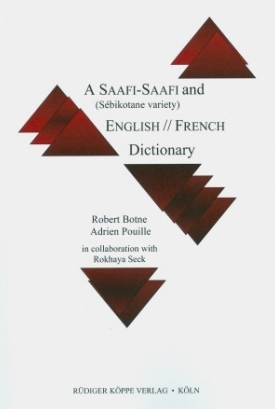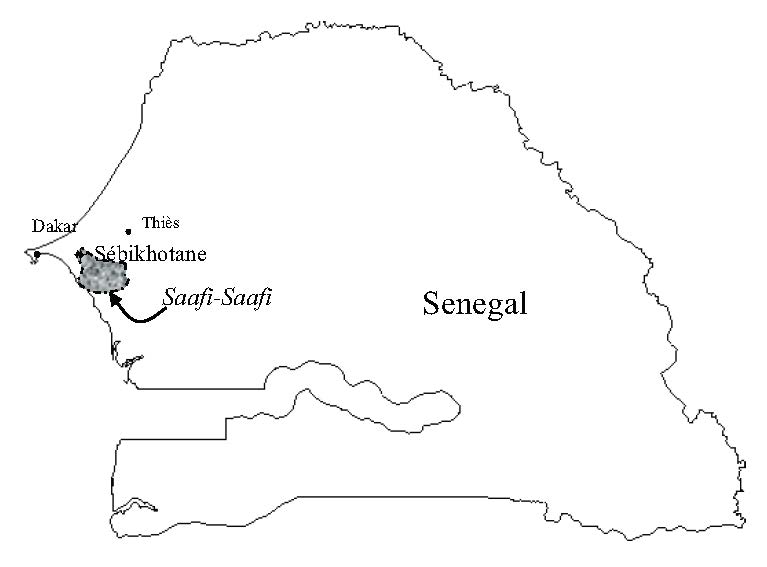

A Saafi-Saafi (Sébikotane Variety) and English // French Dictionary
Compiled by: Robert Botne, Adrien Pouille. In collaboration with: Rokhaya Seck.
201620 pp. Roman, 122 pp.
1 map, 1 colour diagram (Diagram of kinship relations)
Text language(s): English
Format: 160 x 240 mm
290 g
Paperback
€ 39.80
Buy 'A Saafi-Saafi (Sébikotane Variety) and English // French Dictionary' as a downloadable PDF document directly from our online shop »
Order 'A Saafi-Saafi (Sébikotane Variety) and English // French Dictionary' as print edition »
Saafi-Saafi (also known as Safi or Sereer-Safen) is a Cangin language of the Atlantic branch of Niger-Congo, spoken in Senegal (Pichl 1966). Saafen is the name for the area(s) in which Saafi-Saafi is spoken. There are an estimated 200,000 speakers of the language (Lewis et al. 2015), situated primarily in 60 villages across the Thiès region near Dakar. According to Ethnologue (Lewis et al. 2015), there are five dialects of Saafi-Saafi: Boukhou, Sébikotane, Sindia, Hasab, and Diobass. The present work describes aspects of the Sébikotane variety as spoken in and around the town of Sébikotane.
The only other published material on Saafi-Saafi is Mbodj's (1983) doctoral dissertation on the Boukhou variety and three short articles (Dijkstra 2012, Faye and Dijkstra 2005, and Dijkstra and Dijkstra 1997).
This dictionary developed out of work initially conducted in a field methods course at Indiana University during the academic year 2011–2012. Subsequently, additional time was devoted to compiling lexical items from various extant sources as well as from several individual speakers. The dictionary is intended to fulfill two purposes: First, it represents a contribution to the meager published sources that are available on Saafi-Saafi in general, and on the Sébikotane variety in particular. Second, it provides, as part of this introductory guide and in the appendices, some basic information on several aspects of the grammar—noun classes, definiteness and specificity, pronoun paradigms, verb forms and derivations.
The dictionary contains approximately 1,600 headwords for the Sébikotane variety of Saafi-Saafi. Although modest in size, this represents much of the basic vocabulary in the language. The appendices include a listing of kinship terms, noun classes, definiteness marking, pronoun paradigms, numbers, names for days / months / seasons, verb suffixes, and verb tense / aspect marking. This dictionary is intended to serve as a basic resource both for linguists and for those interested in Saafi-Saafi.
Under these links you will find publications by Robert Botne, descriptions of further (West) Atlantic languages and cultures and the complete review of the dictionary by Hillebrand Dijkstra:
Accompanying material:
- A Dictionary of the Kisi Language
(ISBN 978-3-89645-109-5 ) - Aspekte adverbialer Subordination im Hausa, Fulfulde und Kanuri
(ISBN 978-3-89645-469-0 ) - Codeswitching in Gambia
(ISBN 978-3-927620-24-7 ) - Comparing African Spaces
(ISBN 978-3-89645-013-5 ) - Fulfulde-Studien – Fula Studies
(ISBN 978-3-89645-011-1 ) - L’expression du temps en wolof
(ISBN 978-3-89645-557-4 ) - La qualification dans les langues africaines / Qualification in African Languages
(ISBN 978-3-89645-253-5 ) - Language Contact in Guinea
(ISBN 978-3-89645-906-0 ) - Les classes nominales dans les langues atlantiques
(ISBN 978-3-89645-565-9 ) - Morphosyntaxe du jóola banjal
(ISBN 978-3-89645-548-2 ) - Nomades des espaces interstitiels
(ISBN 978-3-89645-252-8 ) - Temne Stories · Erzählungen der Temne · Mump me Themne
(ISBN 978-3-927620-76-6 ) - Vies quotidiennes à Dakar (Sénégal) / Everyday Life in Dakar (Senegal) / Nettaliy dundin ci Ndakaaru, bis bu nekk
(ISBN 978-3-89645-285-6 ) - When Languages Meet
(ISBN 978-3-89645-257-3 )
Cross-reference:
- A Grammatical Sketch of the Lusaamia Verb (E.34/J.34)
(ISBN 978-3-89645-546-8 ) - A Learner’s Chichewa and English Dictionary (N.30)
(ISBN 978-3-927620-10-0 ) - A Lega and English Dictionary (D.25)
(ISBN 978-3-927620-39-1 ) - Domains and Regions in Bantu Tense and Aspect
(ISBN 978-3-89645-772-1 ) - Mpoto Fables and Folktales (N.14, Tanzania)
(ISBN 978-3-89645-738-7 )
Reviews
The dictionary under review is “intended to serve as a basic resource both for linguists and for those interested in Saafi-Saafi”. It should certainly be able to serve both groups. People who want to learn Saafi-Saafi (sav), a Cangin language of the Atlantic branch of Niger-Congo, spoken in Senegal will find it a useful book, and it would be worthwhile investigating how that (small) market could be reached. As the introduction says, it gives much of the basic vocabulary, and with glosses and reverse indexes in both French and English, as well as some basic grammar, it should be able to serve most expatriate and Senegalese learners. Saafi speakers do not single out a “prestigious” or “most correct” dialect, so if some words and expressions are recognisably Sébiois, that should not be a problem. Linguists should also be able to use it, but they should be aware of a few problems in the areas of spelling, grammar and culture.
Hillebrand Dijkstra in Journal of African Languages and Linguistics, 38/2, 2017, 289-292
PDF documents:
 | Review by Hillebrand Dijkstra | (≈ 74 kB) |
| « back | Print version | [top] |
 Books
Books Audio
Audio Biographies
Biographies Series
Series Festschrifts
Festschrifts Journals
Journals